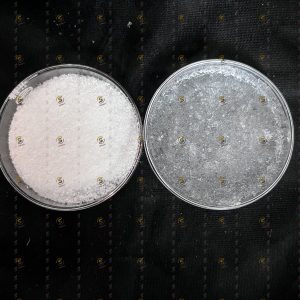The Creator of Sodium Polyacrylate
Sodium polyacrylate, known for its superabsorbent properties, was invented in the late 1960s by the U.S. Department of Agriculture (USDA). This groundbreaking material was the result of research led by Dr. Gene A. Hale and his team, who aimed to develop substances that could significantly enhance soil water retention for agricultural purposes.
The Mechanism Behind Sodium Polyacrylate‘s Water Absorption

Sodium polyacrylate absorbs water due to its distinct chemical composition. It consists of long chains of acrylate monomers, each featuring a carboxyl group. These groups are ionized and attract water molecules through hydrogen bonds and electrostatic interactions. When the polymer comes into contact with water, it swells as the polymer chains extend and capture water molecules. This phenomenon is driven by the polymer’s hydrophilic nature, enabling it to absorb and hold large volumes of water.
The Absorbent Nature of Sodium Polyacrylate
The exceptional absorbency of sodium polyacrylate can be attributed to its cross-linked polymer network. This structure creates numerous spaces within the polymer that can retain water. The presence of sodium ions (Na+) enhances this ability, as they dissociate in water, increasing the osmotic pressure within the polymer matrix and causing it to swell and absorb water extensively.
The Role of Sodium Polyacrylate in Diapers
Sodium polyacrylate is a key component in diapers due to its superior water-absorbing capabilities. It can absorb up to 300 times its weight in water, making it highly effective in keeping the skin dry and preventing leaks. The polymer is integrated into the diaper core, where it quickly absorbs and gels urine. This not only maintains dryness and comfort for the wearer but also helps to prevent diaper rash and other skin issues.
Recycling Sodium Polyacrylate: Challenges and Possibilities
Recycling sodium polyacrylate presents significant challenges due to its complex chemical structure and contamination after use. Although the polymer is not biodegradable, research is ongoing to find viable recycling and disposal methods to reduce its environmental impact. Potential recycling methods include:
- Mechanical Recycling: This involves physically separating used diapers to recover sodium polyacrylate for reuse. However, this method is often labor-intensive and expensive.
- Chemical Recycling: This process involves breaking down sodium polyacrylate into its basic monomers for reuse in new polymer production. While promising, it is still under development and not widely practiced.
- Biodegradation: Researchers are investigating specific bacteria and enzymes that can break down sodium polyacrylate. Although still experimental, this approach holds potential for future biodegradation solutions.
In summary, sodium polyacrylate is a versatile material with wide-ranging applications, especially in hygiene products. Its invention has provided effective solutions for water absorption and retention, greatly enhancing comfort and convenience in everyday life. Despite the challenges associated with its recycling, ongoing research and advancements in technology are paving the way for more sustainable management of this superabsorbent polymer.

